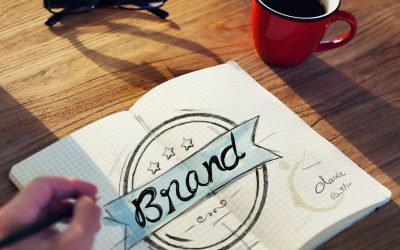The Granny Brand
I hope that you are as lucky as I was to have had two awesome grandmas. Growing up with grandma Evie, I felt safe and loved. At her home, everyone was welcome and there would always be homecooked meals and plenty to go around. Grandma Evie was hard-working, steadfast, reliable, and easy to talk to. With my Grandma Shelby, I felt wild, alive, and encouraged to be exactly who I was! We danced, laughed and together we were the life of the party. Her nickname for me was Animal, and I was encouraged to let it all go and act like one; being with my Grandma Shelby was always footloose and free. Each of my grannies had a distinct, personal brand. You knew what they stood for and how they’d make you feel, and in the simplest description, this is what it means to have a brand. Having a brand is like forming that formidable bond between Granny and Granddaughter. That unbreakable safety, adoration, and love. If you can win your customers over like a grandma wins her grandkids, you are in serious business.
Building Granny’s Good Reputation
Someone recently posed this question, are all businesses brandable? My answer is yes, all businesses have the potential to build a brand. To have a brand is to have a reputation and to make an impression on your customers, so if you have customers, you have the potential of building a brand. This is true even if you are the only business of your type or you are the only company that manufactures a tiny intricate piece that is used in building another product so your customers have no option but to buy from you. While you may not really need to focus on brand development (at least not for now while you don’t have competition), you still have the potential of being brandable. Not only are all businesses brandable, but all businesses should be thinking about brand development and brand strategy from early in the game. A brand is essentially a business’s reputation, and every business has a reputation with their target customer audience, good, bad or indifferent. You get to influence how that reputation unfolds. Too often businesses make the mistake of assuming that a brand is a logo, a tagline, or a one-liner in an advertisement. Those are pieces of their marketing, however, none of them are the brand.
A brand is how your customers think and feel about you. It’s your job as a business owner to ensure that the way you want to be perceived is aligned with how you are actually perceived. All the things you do to bring those things into alignment is essentially the process of brand development. If you had a bad granny and the point hasn’t hit home already, try this: When you think of these people, places, and products, what do you feel? McDonald’s — Red Bull — Donald Trump — Apple — Hillary Clinton — Wal-Mart — Starbucks You may feel indifferent. You may feel disdain or dislike for some, while others provide feelings of hope, stability, or prosperity. How you feel about that business is essentially the brand that they are crafting for the given audience type that you fall within. If you have love for that brand, you may fall within their core audience that they exist for. Businesses don’t need to appeal to all people, they only need to align with their core audience, essentially who they are in business for. For example, one could derive that Starbucks’ primary audience are high-earning, professional adults, 25-40 years of age, living in urban areas, and typically care about social welfare. They appeal to this audience through contemporary design that’s consistent throughout the brand including advertising, décor, and packaging. By staying current in product and décor, Starbucks has become a status symbol for what it means to be affluent, urban, and hip. They appeal to those who care about social welfare through both internal standards and public policy. This isn’t a case-study on Starbucks, this is to demonstrate that every business has a target audience, and it’s imperative for that business to build a good reputation with their core audience, like granny building her good reputation with her granddaughter.
Why Does this Matter for your Business?
Brand development can help your business accomplish several things:
- Improve recognition: When you think of major companies like McDonald’s, Wal-Mart, or Apple, you can likely state what they sell and for whom. They are solving a problem for their ideal customers. Your business can accomplish recognition within your target audience as well. You don’t need to be known by millions, you just need to be known by your ideal customers within your service or market area, so that the next time someone says, “I need help with XYZ,” people think of your business! The other way in which you improve recognition is by creating consistency with your marketing materials including logo, website, print materials, and more. By creating consistency in your materials you become more recognizable and memorable. If someone sees a branded vehicle or print materials, then checks you out online, and then calls on the phone, all of the pieces in this process should echo the same look/feel and vibe. This consistency helps build recognition with current and prospective customers.
- Build Trust: Brand development builds trust in several ways. First, when you identify what you want your customer’s brand experience to be, it gives you something to measure and evaluate against to ensure that you are stacking up. This also allows you to ensure that you are creating consistency in how your products and services are delivered and supported. Creating this reliable and consistent experience builds trust with customers. They can count on you to deliver what they are looking for.
- Build Value: Branding builds value for future sales and growth. A business that has an established name, presence, and reputation is more valuable than one who nobody has heard of; or one that nobody understands. Imagine two companies today. One starts working on their brand including a clear statement about who they serve and why, developing cohesive marketing elements that they use consistently, directed at their target audience, over and over again. The other business has a friend, or someone else working for free and without experience design their logo, and then they change it a few times. They try a few different advertising routes and make up their taglines as they go. They come up with special offers on the fly who are “directed at everyone,” to try and drum up sales. Five years from now one of them is a lot more likely to be known for something specific and valuable, you can guess which that is. Brand development now builds future value.
- Inspire Employees: Branding may inspire employees by providing context for the work that everyone is doing. Many employees, especially today’s millennial workforce, want more than work, they want a bigger mission and vision to work toward. When employees understand the company’s mission, they are more likely to take greater pride in their work and in the company.
Steps you can take: You can start by evaluating or re-evaluating the foundation of your brand. Ask yourself these questions:
- Why are you in business?
- Who is your core customer?
- Why does that audience love you?
- What problem do you solve for that audience?
- What is the brand story that you WANT to be told?
- In what ways is that story currently being cultivated?
- Where are you falling short and what can be improved?
Grannies’ brands live on
All businesses ARE brandable. The key is getting to the root of why you are in business and what your company stands for–your business branding. Your business strategy will change as the market changes and new opportunities arise, but the reason that you exist does not. Those are the things that matter and that truly creates a brand. Would your brand pass the Granny-test? Do you make people feel something that is memorable and distinguishable? Is your business known for something (and something that you want to be known for)? My amazing grannies are both gone from earth, but their brands live on in their reputations and the way they made all of us around them feel. That lasts a lifetime and beyond.

